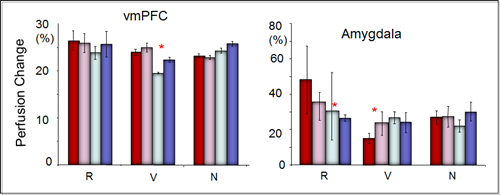
Dr. Lihong Wang’s lab has recently identified the dynamic changing pattern of the cerebral blood perfusion in response to a repeatedly presented stressor over time, which potential can differentiate some individuals who might be vulnerable to depression from individuals who might be resilient to depression (in the figure, V=vulnerable, R=resilient, N=neutral). Those who are potentially vulnerable to depression revealed a decrease in perfusion in the ventromedial prefrontal cortex (vmPFC) and sustained (plateau) perfusion in the amygdala in response to a repeated stressor over time (from the red bar to the blue bar) suggesting a lack of sustained activity of the vmPFC in regulating the response of the amygdala when a stress was repeatedly presented. The pattern of the underlying neural activity could be used for identifying depression vulnerable individuals. Wang et. al. Front. Psychol., 2013; doi:10.3389/fpsyg.2013.00320
